Delirium Assessment Tool Assignment Report
VerifiedAdded on 2022/08/27
|10
|2928
|22
AI Summary
my idea about implementation of delirium assessment tool in intensive care unit .. I need professional writting for leadership course..Reference uodated within 5 years
Contribute Materials
Your contribution can guide someone’s learning journey. Share your
documents today.
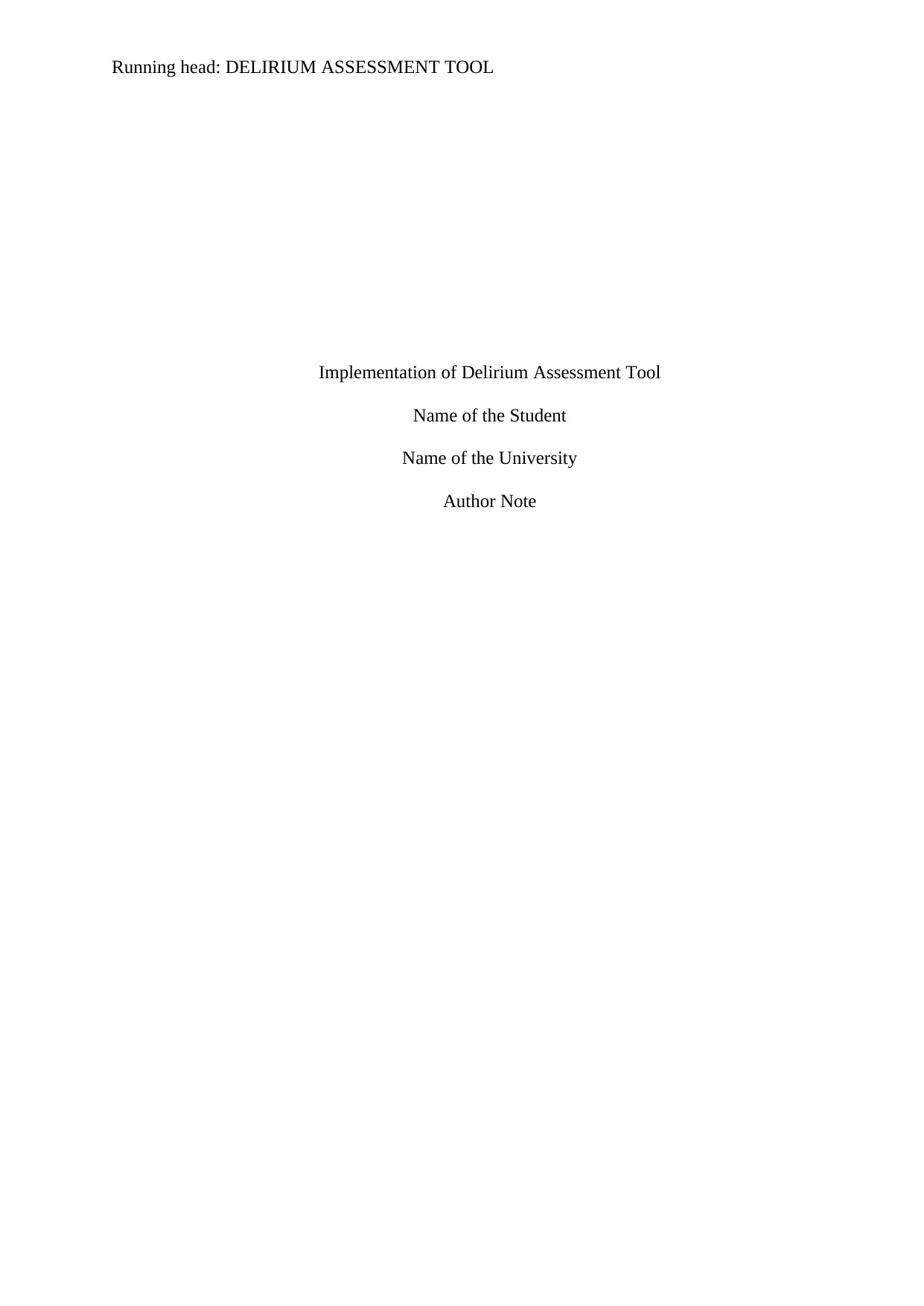
Running head: DELIRIUM ASSESSMENT TOOL
Implementation of Delirium Assessment Tool
Name of the Student
Name of the University
Author Note
Implementation of Delirium Assessment Tool
Name of the Student
Name of the University
Author Note
Secure Best Marks with AI Grader
Need help grading? Try our AI Grader for instant feedback on your assignments.
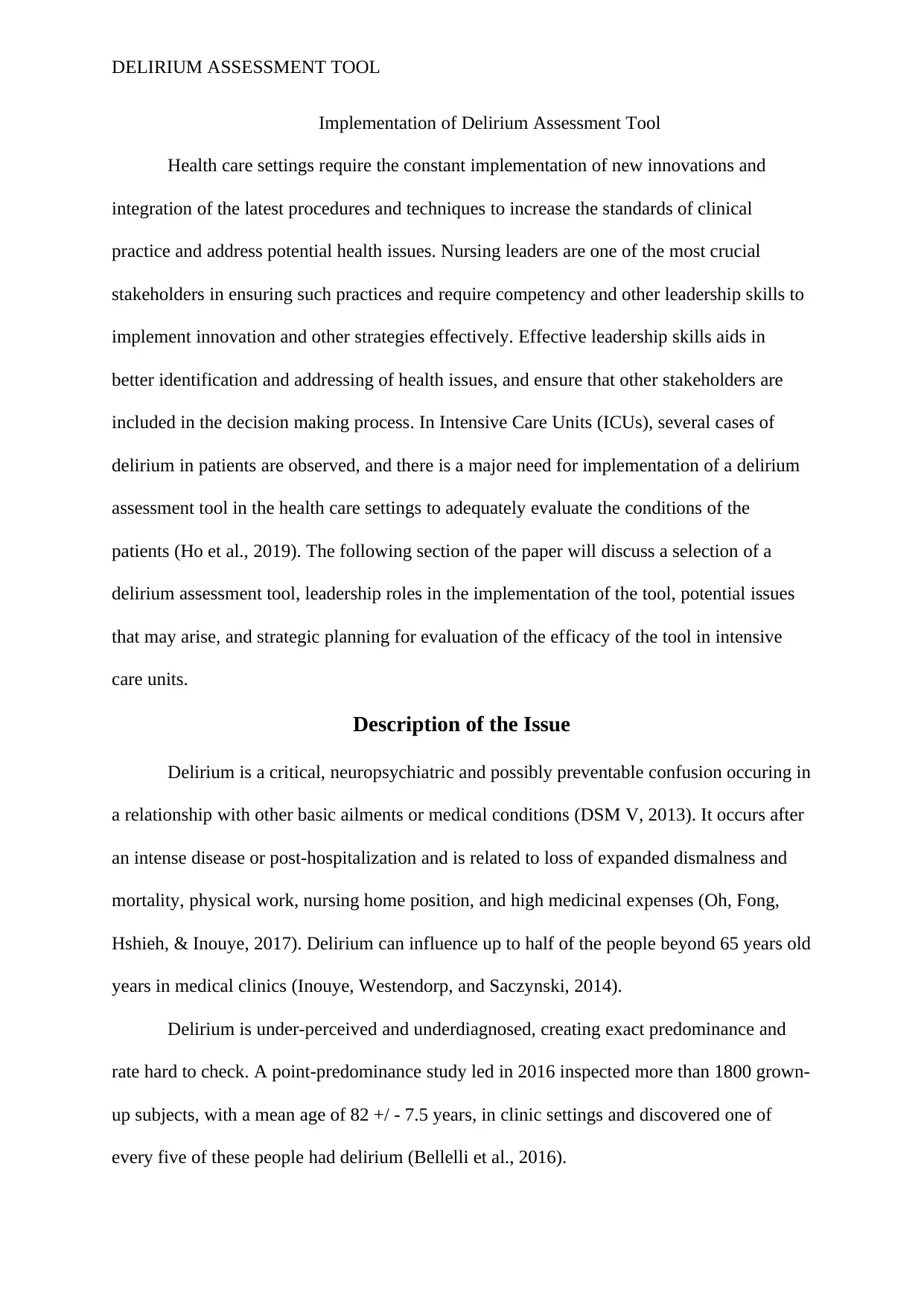
DELIRIUM ASSESSMENT TOOL
Implementation of Delirium Assessment Tool
Health care settings require the constant implementation of new innovations and
integration of the latest procedures and techniques to increase the standards of clinical
practice and address potential health issues. Nursing leaders are one of the most crucial
stakeholders in ensuring such practices and require competency and other leadership skills to
implement innovation and other strategies effectively. Effective leadership skills aids in
better identification and addressing of health issues, and ensure that other stakeholders are
included in the decision making process. In Intensive Care Units (ICUs), several cases of
delirium in patients are observed, and there is a major need for implementation of a delirium
assessment tool in the health care settings to adequately evaluate the conditions of the
patients (Ho et al., 2019). The following section of the paper will discuss a selection of a
delirium assessment tool, leadership roles in the implementation of the tool, potential issues
that may arise, and strategic planning for evaluation of the efficacy of the tool in intensive
care units.
Description of the Issue
Delirium is a critical, neuropsychiatric and possibly preventable confusion occuring in
a relationship with other basic ailments or medical conditions (DSM V, 2013). It occurs after
an intense disease or post-hospitalization and is related to loss of expanded dismalness and
mortality, physical work, nursing home position, and high medicinal expenses (Oh, Fong,
Hshieh, & Inouye, 2017). Delirium can influence up to half of the people beyond 65 years old
years in medical clinics (Inouye, Westendorp, and Saczynski, 2014).
Delirium is under-perceived and underdiagnosed, creating exact predominance and
rate hard to check. A point-predominance study led in 2016 inspected more than 1800 grown-
up subjects, with a mean age of 82 +/ - 7.5 years, in clinic settings and discovered one of
every five of these people had delirium (Bellelli et al., 2016).
Implementation of Delirium Assessment Tool
Health care settings require the constant implementation of new innovations and
integration of the latest procedures and techniques to increase the standards of clinical
practice and address potential health issues. Nursing leaders are one of the most crucial
stakeholders in ensuring such practices and require competency and other leadership skills to
implement innovation and other strategies effectively. Effective leadership skills aids in
better identification and addressing of health issues, and ensure that other stakeholders are
included in the decision making process. In Intensive Care Units (ICUs), several cases of
delirium in patients are observed, and there is a major need for implementation of a delirium
assessment tool in the health care settings to adequately evaluate the conditions of the
patients (Ho et al., 2019). The following section of the paper will discuss a selection of a
delirium assessment tool, leadership roles in the implementation of the tool, potential issues
that may arise, and strategic planning for evaluation of the efficacy of the tool in intensive
care units.
Description of the Issue
Delirium is a critical, neuropsychiatric and possibly preventable confusion occuring in
a relationship with other basic ailments or medical conditions (DSM V, 2013). It occurs after
an intense disease or post-hospitalization and is related to loss of expanded dismalness and
mortality, physical work, nursing home position, and high medicinal expenses (Oh, Fong,
Hshieh, & Inouye, 2017). Delirium can influence up to half of the people beyond 65 years old
years in medical clinics (Inouye, Westendorp, and Saczynski, 2014).
Delirium is under-perceived and underdiagnosed, creating exact predominance and
rate hard to check. A point-predominance study led in 2016 inspected more than 1800 grown-
up subjects, with a mean age of 82 +/ - 7.5 years, in clinic settings and discovered one of
every five of these people had delirium (Bellelli et al., 2016).
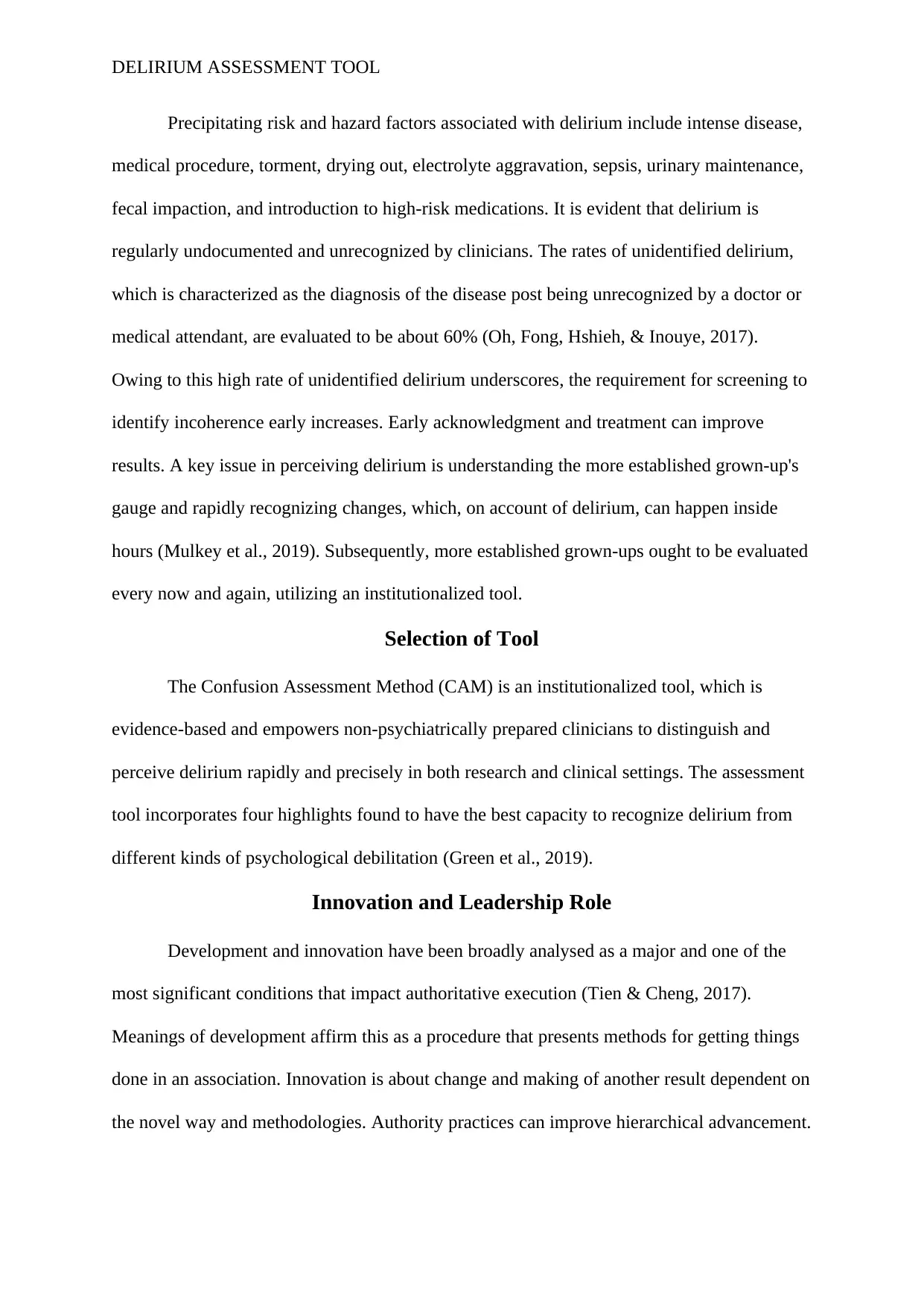
DELIRIUM ASSESSMENT TOOL
Precipitating risk and hazard factors associated with delirium include intense disease,
medical procedure, torment, drying out, electrolyte aggravation, sepsis, urinary maintenance,
fecal impaction, and introduction to high-risk medications. It is evident that delirium is
regularly undocumented and unrecognized by clinicians. The rates of unidentified delirium,
which is characterized as the diagnosis of the disease post being unrecognized by a doctor or
medical attendant, are evaluated to be about 60% (Oh, Fong, Hshieh, & Inouye, 2017).
Owing to this high rate of unidentified delirium underscores, the requirement for screening to
identify incoherence early increases. Early acknowledgment and treatment can improve
results. A key issue in perceiving delirium is understanding the more established grown-up's
gauge and rapidly recognizing changes, which, on account of delirium, can happen inside
hours (Mulkey et al., 2019). Subsequently, more established grown-ups ought to be evaluated
every now and again, utilizing an institutionalized tool.
Selection of Tool
The Confusion Assessment Method (CAM) is an institutionalized tool, which is
evidence-based and empowers non-psychiatrically prepared clinicians to distinguish and
perceive delirium rapidly and precisely in both research and clinical settings. The assessment
tool incorporates four highlights found to have the best capacity to recognize delirium from
different kinds of psychological debilitation (Green et al., 2019).
Innovation and Leadership Role
Development and innovation have been broadly analysed as a major and one of the
most significant conditions that impact authoritative execution (Tien & Cheng, 2017).
Meanings of development affirm this as a procedure that presents methods for getting things
done in an association. Innovation is about change and making of another result dependent on
the novel way and methodologies. Authority practices can improve hierarchical advancement.
Precipitating risk and hazard factors associated with delirium include intense disease,
medical procedure, torment, drying out, electrolyte aggravation, sepsis, urinary maintenance,
fecal impaction, and introduction to high-risk medications. It is evident that delirium is
regularly undocumented and unrecognized by clinicians. The rates of unidentified delirium,
which is characterized as the diagnosis of the disease post being unrecognized by a doctor or
medical attendant, are evaluated to be about 60% (Oh, Fong, Hshieh, & Inouye, 2017).
Owing to this high rate of unidentified delirium underscores, the requirement for screening to
identify incoherence early increases. Early acknowledgment and treatment can improve
results. A key issue in perceiving delirium is understanding the more established grown-up's
gauge and rapidly recognizing changes, which, on account of delirium, can happen inside
hours (Mulkey et al., 2019). Subsequently, more established grown-ups ought to be evaluated
every now and again, utilizing an institutionalized tool.
Selection of Tool
The Confusion Assessment Method (CAM) is an institutionalized tool, which is
evidence-based and empowers non-psychiatrically prepared clinicians to distinguish and
perceive delirium rapidly and precisely in both research and clinical settings. The assessment
tool incorporates four highlights found to have the best capacity to recognize delirium from
different kinds of psychological debilitation (Green et al., 2019).
Innovation and Leadership Role
Development and innovation have been broadly analysed as a major and one of the
most significant conditions that impact authoritative execution (Tien & Cheng, 2017).
Meanings of development affirm this as a procedure that presents methods for getting things
done in an association. Innovation is about change and making of another result dependent on
the novel way and methodologies. Authority practices can improve hierarchical advancement.
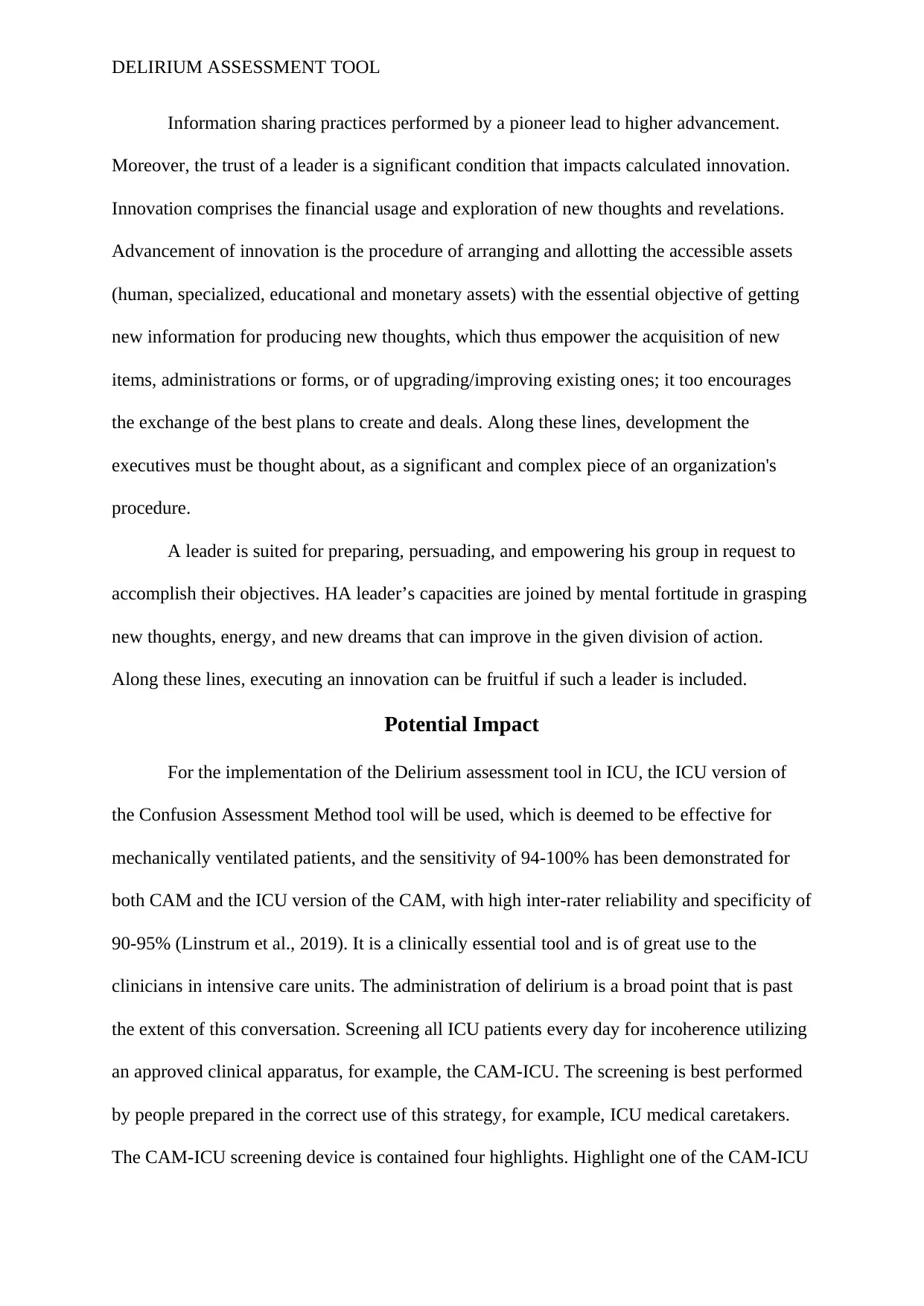
DELIRIUM ASSESSMENT TOOL
Information sharing practices performed by a pioneer lead to higher advancement.
Moreover, the trust of a leader is a significant condition that impacts calculated innovation.
Innovation comprises the financial usage and exploration of new thoughts and revelations.
Advancement of innovation is the procedure of arranging and allotting the accessible assets
(human, specialized, educational and monetary assets) with the essential objective of getting
new information for producing new thoughts, which thus empower the acquisition of new
items, administrations or forms, or of upgrading/improving existing ones; it too encourages
the exchange of the best plans to create and deals. Along these lines, development the
executives must be thought about, as a significant and complex piece of an organization's
procedure.
A leader is suited for preparing, persuading, and empowering his group in request to
accomplish their objectives. HA leader’s capacities are joined by mental fortitude in grasping
new thoughts, energy, and new dreams that can improve in the given division of action.
Along these lines, executing an innovation can be fruitful if such a leader is included.
Potential Impact
For the implementation of the Delirium assessment tool in ICU, the ICU version of
the Confusion Assessment Method tool will be used, which is deemed to be effective for
mechanically ventilated patients, and the sensitivity of 94-100% has been demonstrated for
both CAM and the ICU version of the CAM, with high inter-rater reliability and specificity of
90-95% (Linstrum et al., 2019). It is a clinically essential tool and is of great use to the
clinicians in intensive care units. The administration of delirium is a broad point that is past
the extent of this conversation. Screening all ICU patients every day for incoherence utilizing
an approved clinical apparatus, for example, the CAM-ICU. The screening is best performed
by people prepared in the correct use of this strategy, for example, ICU medical caretakers.
The CAM-ICU screening device is contained four highlights. Highlight one of the CAM-ICU
Information sharing practices performed by a pioneer lead to higher advancement.
Moreover, the trust of a leader is a significant condition that impacts calculated innovation.
Innovation comprises the financial usage and exploration of new thoughts and revelations.
Advancement of innovation is the procedure of arranging and allotting the accessible assets
(human, specialized, educational and monetary assets) with the essential objective of getting
new information for producing new thoughts, which thus empower the acquisition of new
items, administrations or forms, or of upgrading/improving existing ones; it too encourages
the exchange of the best plans to create and deals. Along these lines, development the
executives must be thought about, as a significant and complex piece of an organization's
procedure.
A leader is suited for preparing, persuading, and empowering his group in request to
accomplish their objectives. HA leader’s capacities are joined by mental fortitude in grasping
new thoughts, energy, and new dreams that can improve in the given division of action.
Along these lines, executing an innovation can be fruitful if such a leader is included.
Potential Impact
For the implementation of the Delirium assessment tool in ICU, the ICU version of
the Confusion Assessment Method tool will be used, which is deemed to be effective for
mechanically ventilated patients, and the sensitivity of 94-100% has been demonstrated for
both CAM and the ICU version of the CAM, with high inter-rater reliability and specificity of
90-95% (Linstrum et al., 2019). It is a clinically essential tool and is of great use to the
clinicians in intensive care units. The administration of delirium is a broad point that is past
the extent of this conversation. Screening all ICU patients every day for incoherence utilizing
an approved clinical apparatus, for example, the CAM-ICU. The screening is best performed
by people prepared in the correct use of this strategy, for example, ICU medical caretakers.
The CAM-ICU screening device is contained four highlights. Highlight one of the CAM-ICU
Secure Best Marks with AI Grader
Need help grading? Try our AI Grader for instant feedback on your assignments.
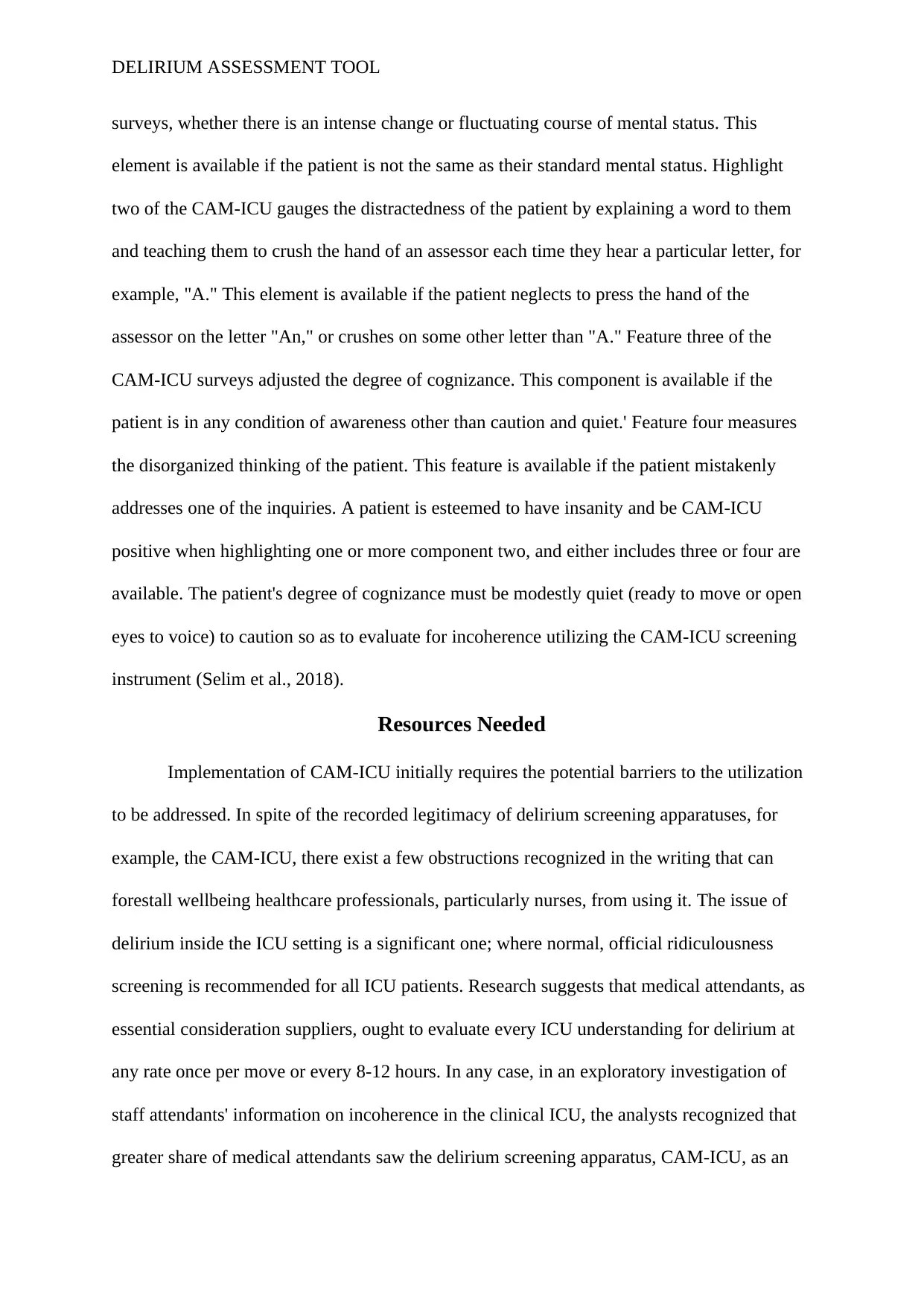
DELIRIUM ASSESSMENT TOOL
surveys, whether there is an intense change or fluctuating course of mental status. This
element is available if the patient is not the same as their standard mental status. Highlight
two of the CAM-ICU gauges the distractedness of the patient by explaining a word to them
and teaching them to crush the hand of an assessor each time they hear a particular letter, for
example, "A." This element is available if the patient neglects to press the hand of the
assessor on the letter "An," or crushes on some other letter than "A." Feature three of the
CAM-ICU surveys adjusted the degree of cognizance. This component is available if the
patient is in any condition of awareness other than caution and quiet.' Feature four measures
the disorganized thinking of the patient. This feature is available if the patient mistakenly
addresses one of the inquiries. A patient is esteemed to have insanity and be CAM-ICU
positive when highlighting one or more component two, and either includes three or four are
available. The patient's degree of cognizance must be modestly quiet (ready to move or open
eyes to voice) to caution so as to evaluate for incoherence utilizing the CAM-ICU screening
instrument (Selim et al., 2018).
Resources Needed
Implementation of CAM-ICU initially requires the potential barriers to the utilization
to be addressed. In spite of the recorded legitimacy of delirium screening apparatuses, for
example, the CAM-ICU, there exist a few obstructions recognized in the writing that can
forestall wellbeing healthcare professionals, particularly nurses, from using it. The issue of
delirium inside the ICU setting is a significant one; where normal, official ridiculousness
screening is recommended for all ICU patients. Research suggests that medical attendants, as
essential consideration suppliers, ought to evaluate every ICU understanding for delirium at
any rate once per move or every 8-12 hours. In any case, in an exploratory investigation of
staff attendants' information on incoherence in the clinical ICU, the analysts recognized that
greater share of medical attendants saw the delirium screening apparatus, CAM-ICU, as an
surveys, whether there is an intense change or fluctuating course of mental status. This
element is available if the patient is not the same as their standard mental status. Highlight
two of the CAM-ICU gauges the distractedness of the patient by explaining a word to them
and teaching them to crush the hand of an assessor each time they hear a particular letter, for
example, "A." This element is available if the patient neglects to press the hand of the
assessor on the letter "An," or crushes on some other letter than "A." Feature three of the
CAM-ICU surveys adjusted the degree of cognizance. This component is available if the
patient is in any condition of awareness other than caution and quiet.' Feature four measures
the disorganized thinking of the patient. This feature is available if the patient mistakenly
addresses one of the inquiries. A patient is esteemed to have insanity and be CAM-ICU
positive when highlighting one or more component two, and either includes three or four are
available. The patient's degree of cognizance must be modestly quiet (ready to move or open
eyes to voice) to caution so as to evaluate for incoherence utilizing the CAM-ICU screening
instrument (Selim et al., 2018).
Resources Needed
Implementation of CAM-ICU initially requires the potential barriers to the utilization
to be addressed. In spite of the recorded legitimacy of delirium screening apparatuses, for
example, the CAM-ICU, there exist a few obstructions recognized in the writing that can
forestall wellbeing healthcare professionals, particularly nurses, from using it. The issue of
delirium inside the ICU setting is a significant one; where normal, official ridiculousness
screening is recommended for all ICU patients. Research suggests that medical attendants, as
essential consideration suppliers, ought to evaluate every ICU understanding for delirium at
any rate once per move or every 8-12 hours. In any case, in an exploratory investigation of
staff attendants' information on incoherence in the clinical ICU, the analysts recognized that
greater share of medical attendants saw the delirium screening apparatus, CAM-ICU, as an
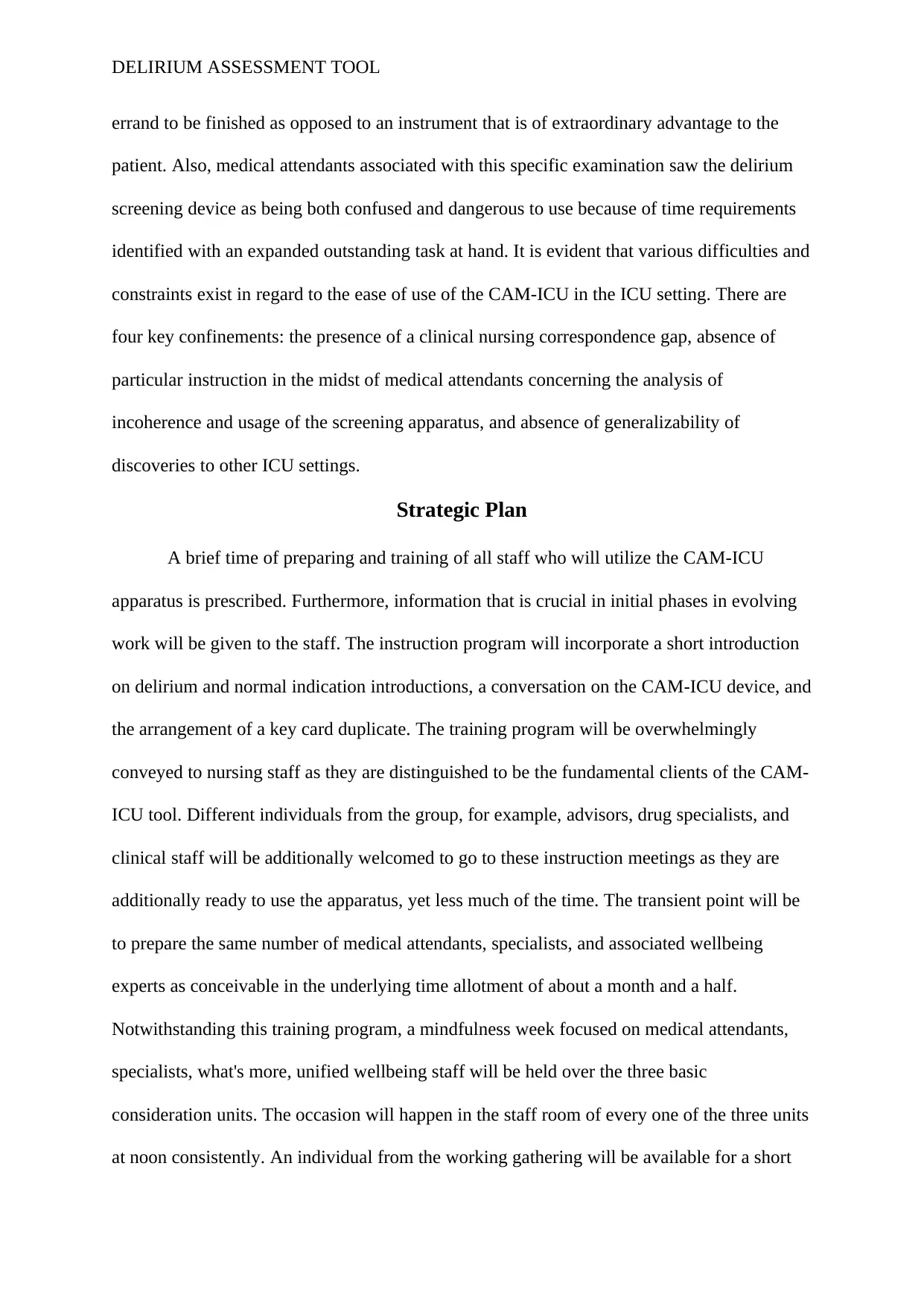
DELIRIUM ASSESSMENT TOOL
errand to be finished as opposed to an instrument that is of extraordinary advantage to the
patient. Also, medical attendants associated with this specific examination saw the delirium
screening device as being both confused and dangerous to use because of time requirements
identified with an expanded outstanding task at hand. It is evident that various difficulties and
constraints exist in regard to the ease of use of the CAM-ICU in the ICU setting. There are
four key confinements: the presence of a clinical nursing correspondence gap, absence of
particular instruction in the midst of medical attendants concerning the analysis of
incoherence and usage of the screening apparatus, and absence of generalizability of
discoveries to other ICU settings.
Strategic Plan
A brief time of preparing and training of all staff who will utilize the CAM-ICU
apparatus is prescribed. Furthermore, information that is crucial in initial phases in evolving
work will be given to the staff. The instruction program will incorporate a short introduction
on delirium and normal indication introductions, a conversation on the CAM-ICU device, and
the arrangement of a key card duplicate. The training program will be overwhelmingly
conveyed to nursing staff as they are distinguished to be the fundamental clients of the CAM-
ICU tool. Different individuals from the group, for example, advisors, drug specialists, and
clinical staff will be additionally welcomed to go to these instruction meetings as they are
additionally ready to use the apparatus, yet less much of the time. The transient point will be
to prepare the same number of medical attendants, specialists, and associated wellbeing
experts as conceivable in the underlying time allotment of about a month and a half.
Notwithstanding this training program, a mindfulness week focused on medical attendants,
specialists, what's more, unified wellbeing staff will be held over the three basic
consideration units. The occasion will happen in the staff room of every one of the three units
at noon consistently. An individual from the working gathering will be available for a short
errand to be finished as opposed to an instrument that is of extraordinary advantage to the
patient. Also, medical attendants associated with this specific examination saw the delirium
screening device as being both confused and dangerous to use because of time requirements
identified with an expanded outstanding task at hand. It is evident that various difficulties and
constraints exist in regard to the ease of use of the CAM-ICU in the ICU setting. There are
four key confinements: the presence of a clinical nursing correspondence gap, absence of
particular instruction in the midst of medical attendants concerning the analysis of
incoherence and usage of the screening apparatus, and absence of generalizability of
discoveries to other ICU settings.
Strategic Plan
A brief time of preparing and training of all staff who will utilize the CAM-ICU
apparatus is prescribed. Furthermore, information that is crucial in initial phases in evolving
work will be given to the staff. The instruction program will incorporate a short introduction
on delirium and normal indication introductions, a conversation on the CAM-ICU device, and
the arrangement of a key card duplicate. The training program will be overwhelmingly
conveyed to nursing staff as they are distinguished to be the fundamental clients of the CAM-
ICU tool. Different individuals from the group, for example, advisors, drug specialists, and
clinical staff will be additionally welcomed to go to these instruction meetings as they are
additionally ready to use the apparatus, yet less much of the time. The transient point will be
to prepare the same number of medical attendants, specialists, and associated wellbeing
experts as conceivable in the underlying time allotment of about a month and a half.
Notwithstanding this training program, a mindfulness week focused on medical attendants,
specialists, what's more, unified wellbeing staff will be held over the three basic
consideration units. The occasion will happen in the staff room of every one of the three units
at noon consistently. An individual from the working gathering will be available for a short
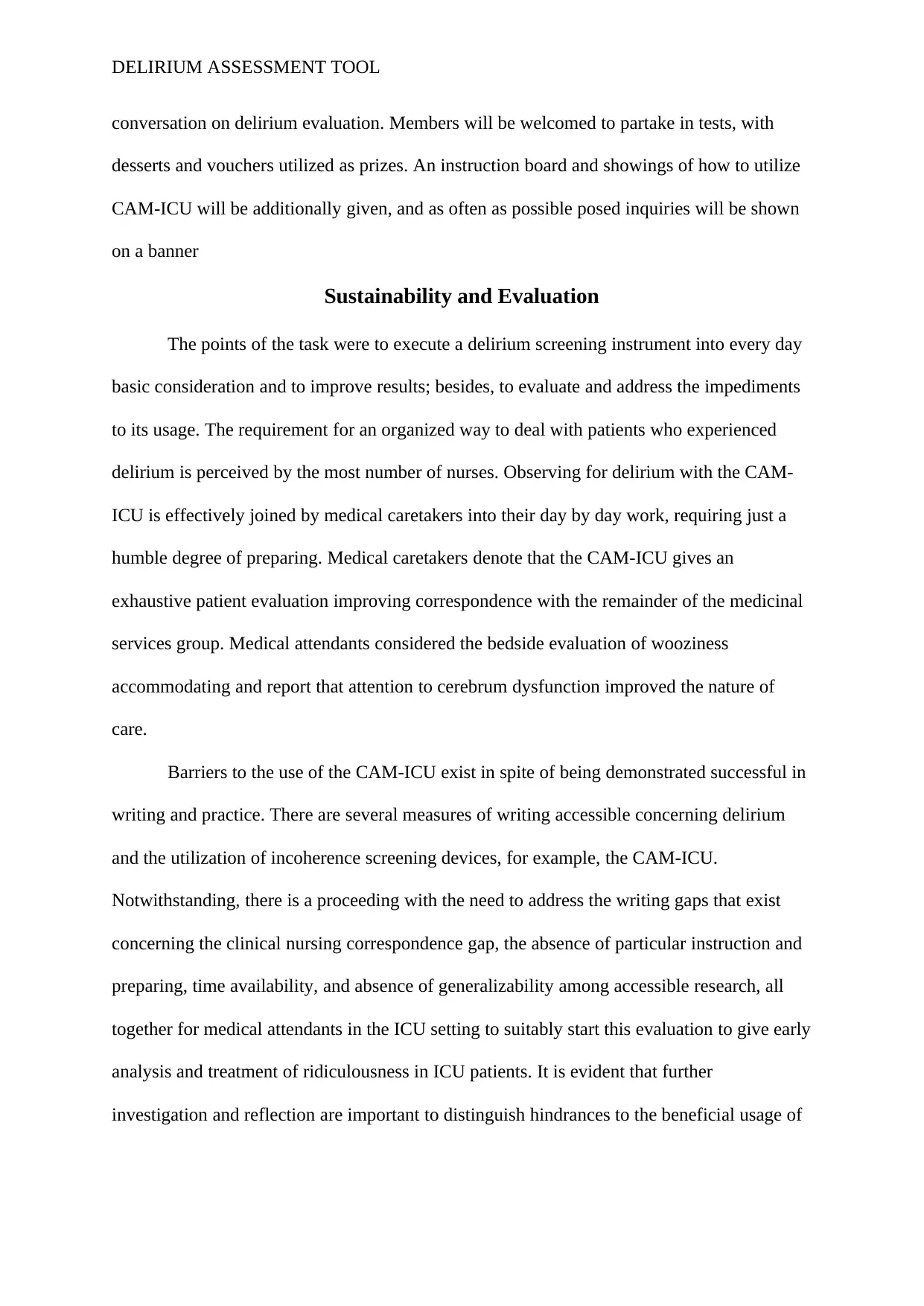
DELIRIUM ASSESSMENT TOOL
conversation on delirium evaluation. Members will be welcomed to partake in tests, with
desserts and vouchers utilized as prizes. An instruction board and showings of how to utilize
CAM-ICU will be additionally given, and as often as possible posed inquiries will be shown
on a banner
Sustainability and Evaluation
The points of the task were to execute a delirium screening instrument into every day
basic consideration and to improve results; besides, to evaluate and address the impediments
to its usage. The requirement for an organized way to deal with patients who experienced
delirium is perceived by the most number of nurses. Observing for delirium with the CAM-
ICU is effectively joined by medical caretakers into their day by day work, requiring just a
humble degree of preparing. Medical caretakers denote that the CAM-ICU gives an
exhaustive patient evaluation improving correspondence with the remainder of the medicinal
services group. Medical attendants considered the bedside evaluation of wooziness
accommodating and report that attention to cerebrum dysfunction improved the nature of
care.
Barriers to the use of the CAM-ICU exist in spite of being demonstrated successful in
writing and practice. There are several measures of writing accessible concerning delirium
and the utilization of incoherence screening devices, for example, the CAM-ICU.
Notwithstanding, there is a proceeding with the need to address the writing gaps that exist
concerning the clinical nursing correspondence gap, the absence of particular instruction and
preparing, time availability, and absence of generalizability among accessible research, all
together for medical attendants in the ICU setting to suitably start this evaluation to give early
analysis and treatment of ridiculousness in ICU patients. It is evident that further
investigation and reflection are important to distinguish hindrances to the beneficial usage of
conversation on delirium evaluation. Members will be welcomed to partake in tests, with
desserts and vouchers utilized as prizes. An instruction board and showings of how to utilize
CAM-ICU will be additionally given, and as often as possible posed inquiries will be shown
on a banner
Sustainability and Evaluation
The points of the task were to execute a delirium screening instrument into every day
basic consideration and to improve results; besides, to evaluate and address the impediments
to its usage. The requirement for an organized way to deal with patients who experienced
delirium is perceived by the most number of nurses. Observing for delirium with the CAM-
ICU is effectively joined by medical caretakers into their day by day work, requiring just a
humble degree of preparing. Medical caretakers denote that the CAM-ICU gives an
exhaustive patient evaluation improving correspondence with the remainder of the medicinal
services group. Medical attendants considered the bedside evaluation of wooziness
accommodating and report that attention to cerebrum dysfunction improved the nature of
care.
Barriers to the use of the CAM-ICU exist in spite of being demonstrated successful in
writing and practice. There are several measures of writing accessible concerning delirium
and the utilization of incoherence screening devices, for example, the CAM-ICU.
Notwithstanding, there is a proceeding with the need to address the writing gaps that exist
concerning the clinical nursing correspondence gap, the absence of particular instruction and
preparing, time availability, and absence of generalizability among accessible research, all
together for medical attendants in the ICU setting to suitably start this evaluation to give early
analysis and treatment of ridiculousness in ICU patients. It is evident that further
investigation and reflection are important to distinguish hindrances to the beneficial usage of
Paraphrase This Document
Need a fresh take? Get an instant paraphrase of this document with our AI Paraphraser
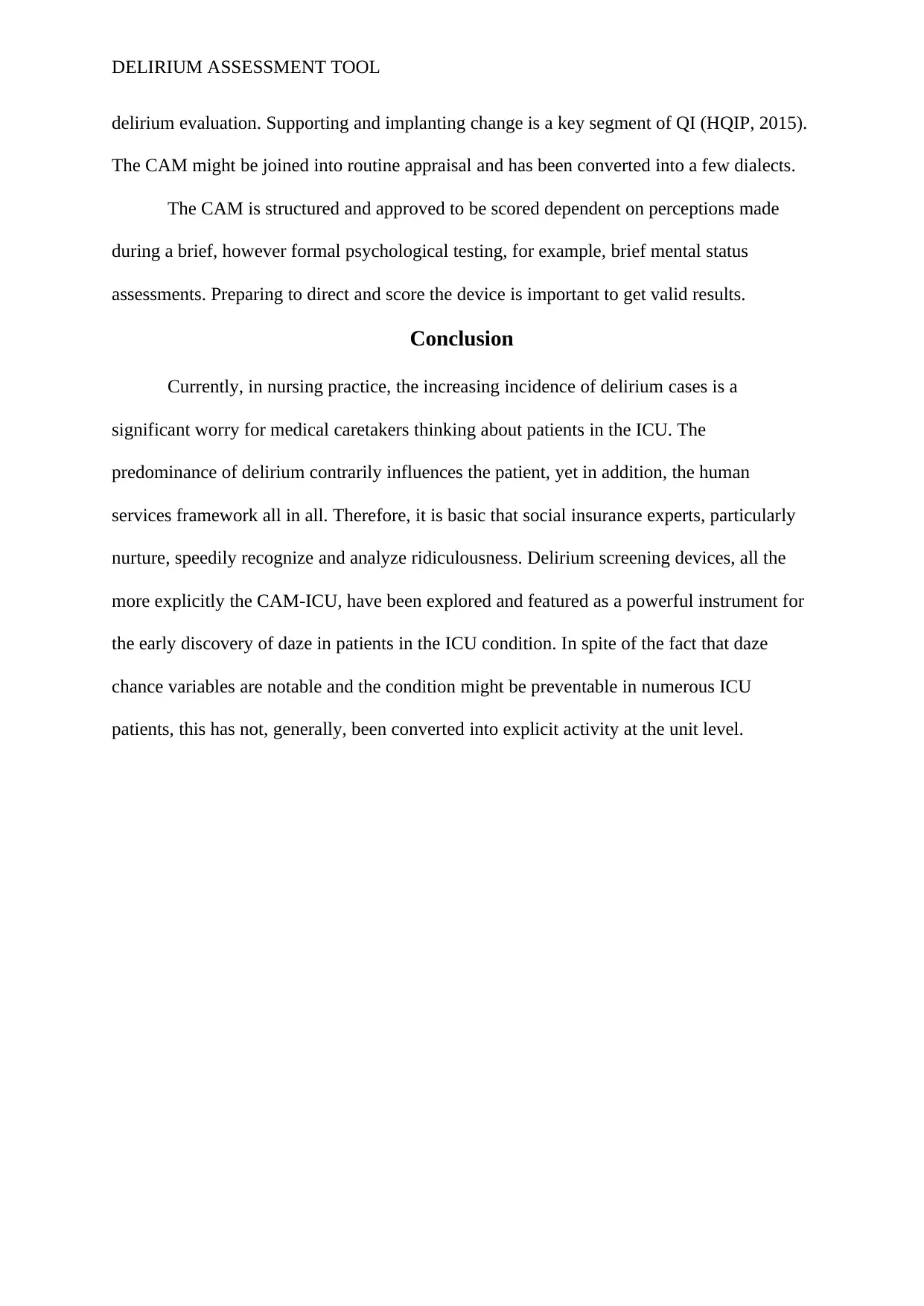
DELIRIUM ASSESSMENT TOOL
delirium evaluation. Supporting and implanting change is a key segment of QI (HQIP, 2015).
The CAM might be joined into routine appraisal and has been converted into a few dialects.
The CAM is structured and approved to be scored dependent on perceptions made
during a brief, however formal psychological testing, for example, brief mental status
assessments. Preparing to direct and score the device is important to get valid results.
Conclusion
Currently, in nursing practice, the increasing incidence of delirium cases is a
significant worry for medical caretakers thinking about patients in the ICU. The
predominance of delirium contrarily influences the patient, yet in addition, the human
services framework all in all. Therefore, it is basic that social insurance experts, particularly
nurture, speedily recognize and analyze ridiculousness. Delirium screening devices, all the
more explicitly the CAM-ICU, have been explored and featured as a powerful instrument for
the early discovery of daze in patients in the ICU condition. In spite of the fact that daze
chance variables are notable and the condition might be preventable in numerous ICU
patients, this has not, generally, been converted into explicit activity at the unit level.
delirium evaluation. Supporting and implanting change is a key segment of QI (HQIP, 2015).
The CAM might be joined into routine appraisal and has been converted into a few dialects.
The CAM is structured and approved to be scored dependent on perceptions made
during a brief, however formal psychological testing, for example, brief mental status
assessments. Preparing to direct and score the device is important to get valid results.
Conclusion
Currently, in nursing practice, the increasing incidence of delirium cases is a
significant worry for medical caretakers thinking about patients in the ICU. The
predominance of delirium contrarily influences the patient, yet in addition, the human
services framework all in all. Therefore, it is basic that social insurance experts, particularly
nurture, speedily recognize and analyze ridiculousness. Delirium screening devices, all the
more explicitly the CAM-ICU, have been explored and featured as a powerful instrument for
the early discovery of daze in patients in the ICU condition. In spite of the fact that daze
chance variables are notable and the condition might be preventable in numerous ICU
patients, this has not, generally, been converted into explicit activity at the unit level.
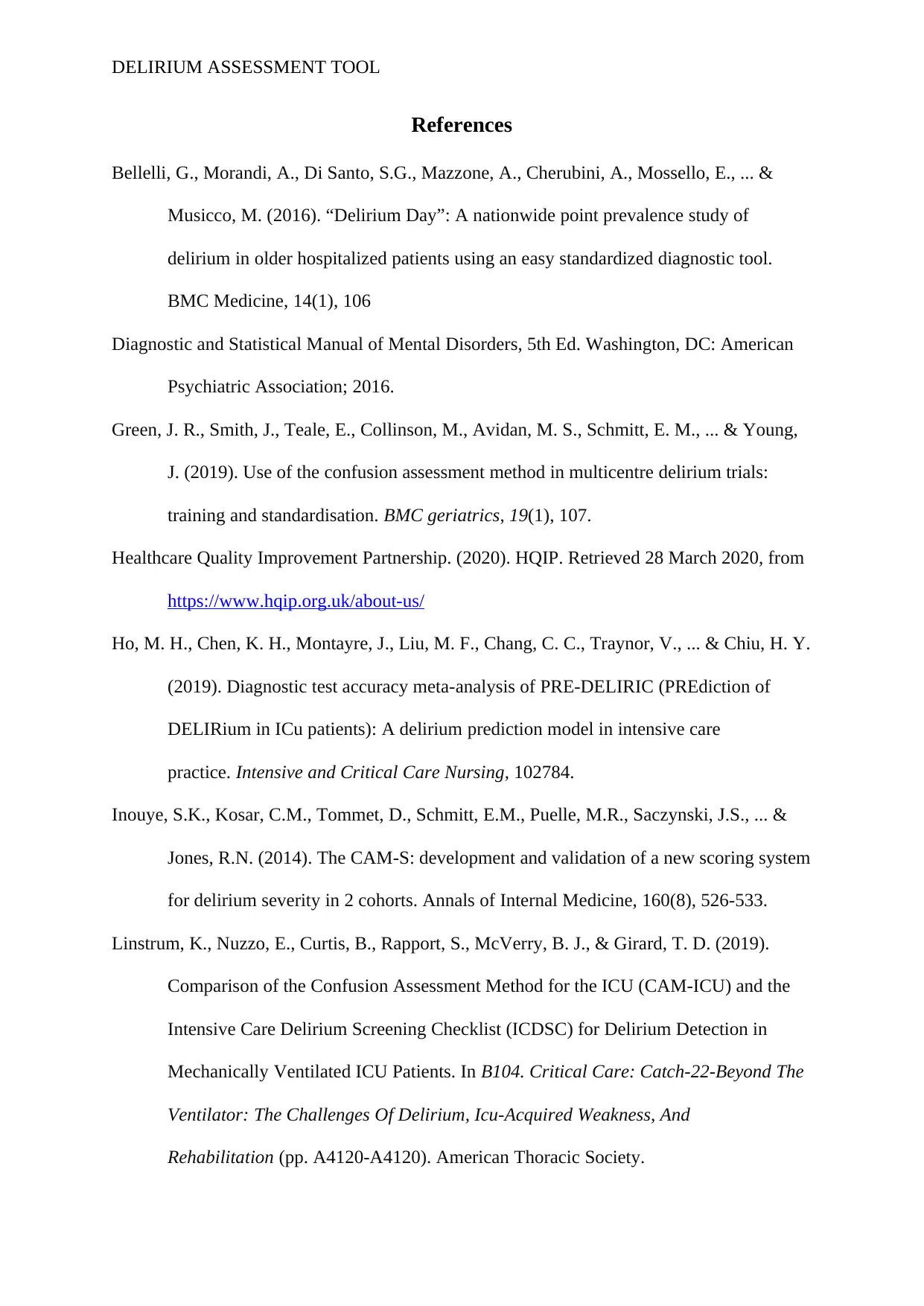
DELIRIUM ASSESSMENT TOOL
References
Bellelli, G., Morandi, A., Di Santo, S.G., Mazzone, A., Cherubini, A., Mossello, E., ... &
Musicco, M. (2016). “Delirium Day”: A nationwide point prevalence study of
delirium in older hospitalized patients using an easy standardized diagnostic tool.
BMC Medicine, 14(1), 106
Diagnostic and Statistical Manual of Mental Disorders, 5th Ed. Washington, DC: American
Psychiatric Association; 2016.
Green, J. R., Smith, J., Teale, E., Collinson, M., Avidan, M. S., Schmitt, E. M., ... & Young,
J. (2019). Use of the confusion assessment method in multicentre delirium trials:
training and standardisation. BMC geriatrics, 19(1), 107.
Healthcare Quality Improvement Partnership. (2020). HQIP. Retrieved 28 March 2020, from
https://www.hqip.org.uk/about-us/
Ho, M. H., Chen, K. H., Montayre, J., Liu, M. F., Chang, C. C., Traynor, V., ... & Chiu, H. Y.
(2019). Diagnostic test accuracy meta-analysis of PRE-DELIRIC (PREdiction of
DELIRium in ICu patients): A delirium prediction model in intensive care
practice. Intensive and Critical Care Nursing, 102784.
Inouye, S.K., Kosar, C.M., Tommet, D., Schmitt, E.M., Puelle, M.R., Saczynski, J.S., ... &
Jones, R.N. (2014). The CAM-S: development and validation of a new scoring system
for delirium severity in 2 cohorts. Annals of Internal Medicine, 160(8), 526-533.
Linstrum, K., Nuzzo, E., Curtis, B., Rapport, S., McVerry, B. J., & Girard, T. D. (2019).
Comparison of the Confusion Assessment Method for the ICU (CAM-ICU) and the
Intensive Care Delirium Screening Checklist (ICDSC) for Delirium Detection in
Mechanically Ventilated ICU Patients. In B104. Critical Care: Catch-22-Beyond The
Ventilator: The Challenges Of Delirium, Icu-Acquired Weakness, And
Rehabilitation (pp. A4120-A4120). American Thoracic Society.
References
Bellelli, G., Morandi, A., Di Santo, S.G., Mazzone, A., Cherubini, A., Mossello, E., ... &
Musicco, M. (2016). “Delirium Day”: A nationwide point prevalence study of
delirium in older hospitalized patients using an easy standardized diagnostic tool.
BMC Medicine, 14(1), 106
Diagnostic and Statistical Manual of Mental Disorders, 5th Ed. Washington, DC: American
Psychiatric Association; 2016.
Green, J. R., Smith, J., Teale, E., Collinson, M., Avidan, M. S., Schmitt, E. M., ... & Young,
J. (2019). Use of the confusion assessment method in multicentre delirium trials:
training and standardisation. BMC geriatrics, 19(1), 107.
Healthcare Quality Improvement Partnership. (2020). HQIP. Retrieved 28 March 2020, from
https://www.hqip.org.uk/about-us/
Ho, M. H., Chen, K. H., Montayre, J., Liu, M. F., Chang, C. C., Traynor, V., ... & Chiu, H. Y.
(2019). Diagnostic test accuracy meta-analysis of PRE-DELIRIC (PREdiction of
DELIRium in ICu patients): A delirium prediction model in intensive care
practice. Intensive and Critical Care Nursing, 102784.
Inouye, S.K., Kosar, C.M., Tommet, D., Schmitt, E.M., Puelle, M.R., Saczynski, J.S., ... &
Jones, R.N. (2014). The CAM-S: development and validation of a new scoring system
for delirium severity in 2 cohorts. Annals of Internal Medicine, 160(8), 526-533.
Linstrum, K., Nuzzo, E., Curtis, B., Rapport, S., McVerry, B. J., & Girard, T. D. (2019).
Comparison of the Confusion Assessment Method for the ICU (CAM-ICU) and the
Intensive Care Delirium Screening Checklist (ICDSC) for Delirium Detection in
Mechanically Ventilated ICU Patients. In B104. Critical Care: Catch-22-Beyond The
Ventilator: The Challenges Of Delirium, Icu-Acquired Weakness, And
Rehabilitation (pp. A4120-A4120). American Thoracic Society.
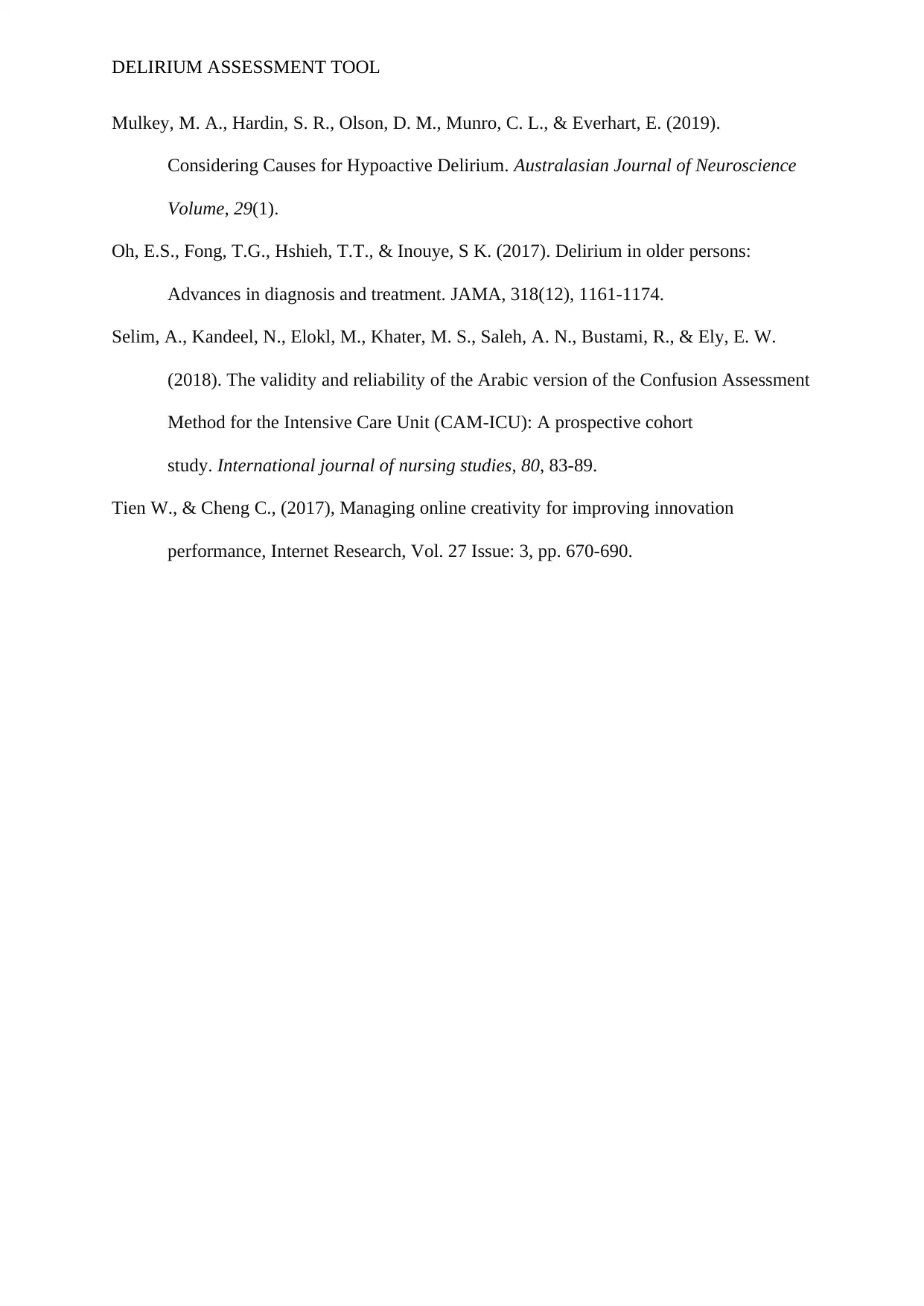
DELIRIUM ASSESSMENT TOOL
Mulkey, M. A., Hardin, S. R., Olson, D. M., Munro, C. L., & Everhart, E. (2019).
Considering Causes for Hypoactive Delirium. Australasian Journal of Neuroscience
Volume, 29(1).
Oh, E.S., Fong, T.G., Hshieh, T.T., & Inouye, S K. (2017). Delirium in older persons:
Advances in diagnosis and treatment. JAMA, 318(12), 1161-1174.
Selim, A., Kandeel, N., Elokl, M., Khater, M. S., Saleh, A. N., Bustami, R., & Ely, E. W.
(2018). The validity and reliability of the Arabic version of the Confusion Assessment
Method for the Intensive Care Unit (CAM-ICU): A prospective cohort
study. International journal of nursing studies, 80, 83-89.
Tien W., & Cheng C., (2017), Managing online creativity for improving innovation
performance, Internet Research, Vol. 27 Issue: 3, pp. 670-690.
Mulkey, M. A., Hardin, S. R., Olson, D. M., Munro, C. L., & Everhart, E. (2019).
Considering Causes for Hypoactive Delirium. Australasian Journal of Neuroscience
Volume, 29(1).
Oh, E.S., Fong, T.G., Hshieh, T.T., & Inouye, S K. (2017). Delirium in older persons:
Advances in diagnosis and treatment. JAMA, 318(12), 1161-1174.
Selim, A., Kandeel, N., Elokl, M., Khater, M. S., Saleh, A. N., Bustami, R., & Ely, E. W.
(2018). The validity and reliability of the Arabic version of the Confusion Assessment
Method for the Intensive Care Unit (CAM-ICU): A prospective cohort
study. International journal of nursing studies, 80, 83-89.
Tien W., & Cheng C., (2017), Managing online creativity for improving innovation
performance, Internet Research, Vol. 27 Issue: 3, pp. 670-690.
1 out of 10
Your All-in-One AI-Powered Toolkit for Academic Success.
+13062052269
info@desklib.com
Available 24*7 on WhatsApp / Email
![[object Object]](/_next/static/media/star-bottom.7253800d.svg)
Unlock your academic potential
© 2024 | Zucol Services PVT LTD | All rights reserved.